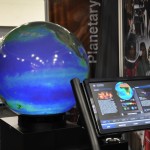Stunning Spherical Visualizations with Projection Globe
Whether it’s illuminating the magical topography of Jupiter and its moons or modeling climate-change impact on Earth’s ice caps, the Magic Planet projection globe provides striking visual imaging for an unparalleled interactive learning experience.
Unique Projection Globe Image Display
All Magic Planet projection globes feature a “rear projection display device” with a sphere-shaped screen. A digital projector shines an image through a specialized lens, which distributes light evenly and in focus around the projection globe’s screen. The spherical screen has a unique coating on the inside so that the image display is continuous and equally bright around the projection globe, regardless of viewing angle (unlike other rear projection screens that appear to darken as a viewer moves to the side of the projection globe). Fabricated with durable acrylic, the Magic Planet projection globe comes standard with anti-glare coating, and can be washed with soap and water for easy maintenance.
Dual HD Projection Globe Technology
The Magic Planet Dual High-Definition projection globe system produces the absolute sharpest and brightest spherical display available anywhere in the world and is offered with a wide range of spheres, starting with the 3′ (91cm) model. The system uses two HD projectors to provide precision visualizations, but is driven by a single computer—making use both cost effective and uncomplicated. The dual HD projection globe utilizes patented lens technology, which merges the output of two high-definition projectors into one ultra-high-resolution, distortion-free image. Real-time edge blending and projector color matching ensure that rendering is perfectly crisp and true to life. What results is a spectacular 2.9 million pixels of breathtaking imagery.
Projection Globe Potential
Exemplifying the educational possibilities, various applications for the Magic Planet projection globe come with rich media content utilizing the technology in extraordinary ways. For example, Eyes on the Earth from the Elumenati and JPL incorporates feeds of global data from satellite locations. Other notable projection globe applications include a full virtualized solar system tour, “globe movie” digital animation projects, and geography lesson visualizations that stream real-time weather and earthquake feeds.

